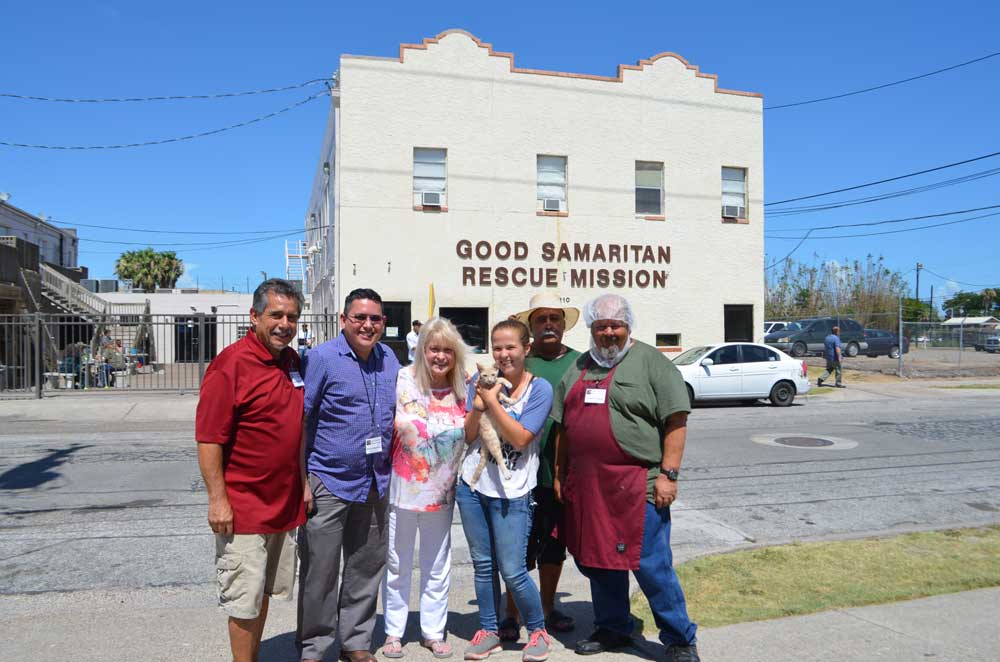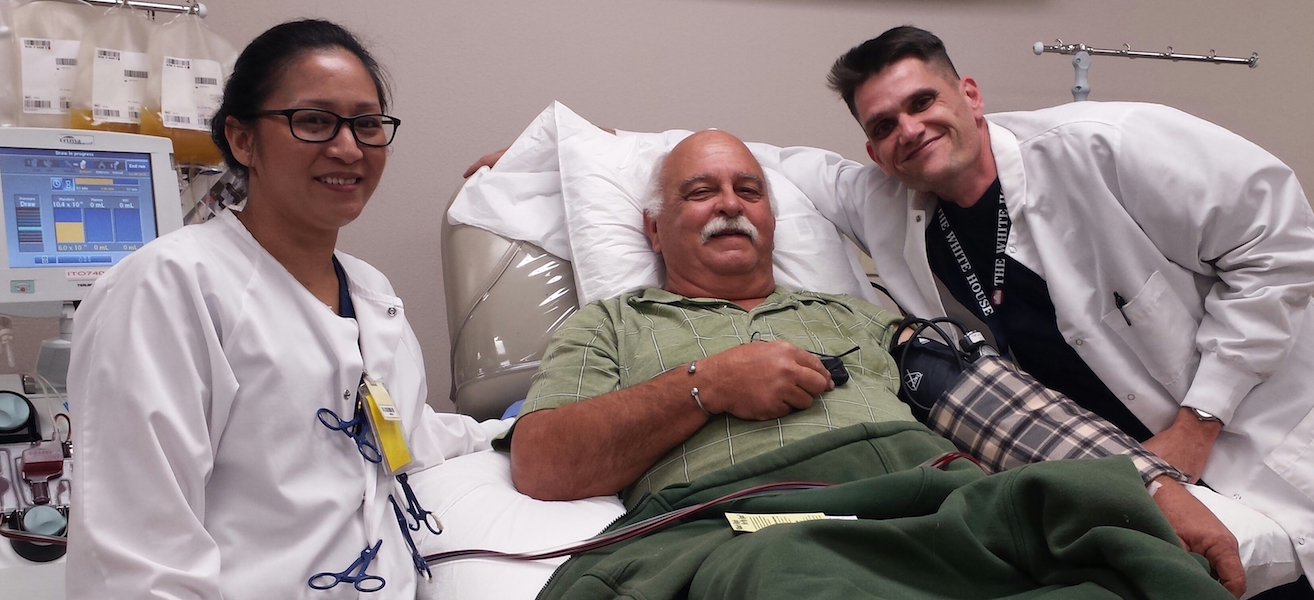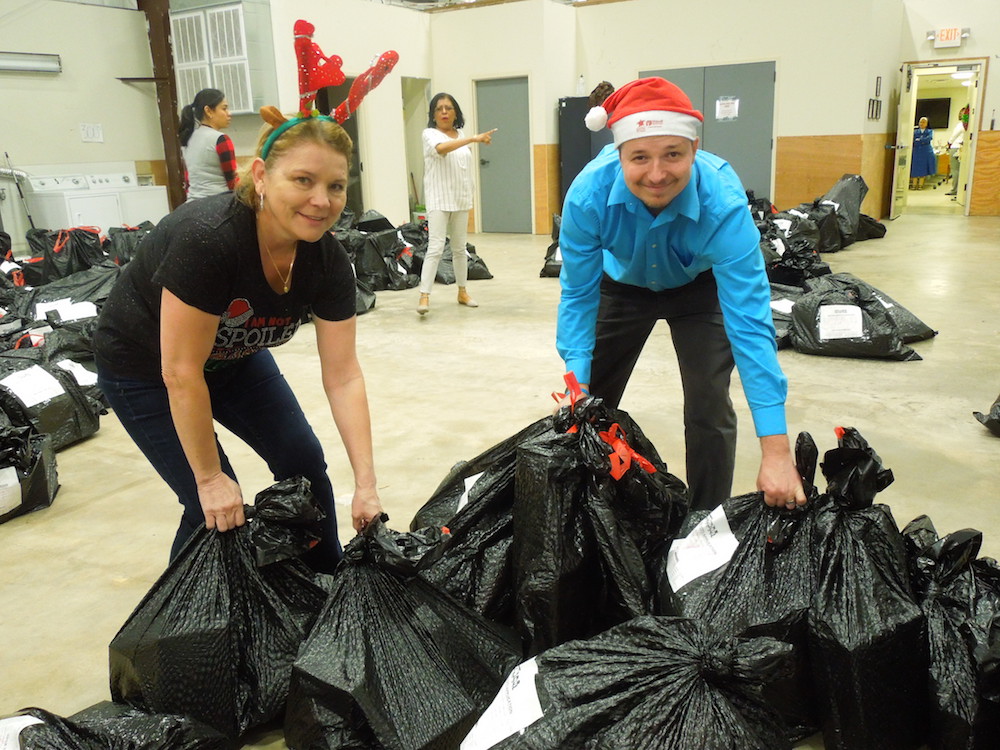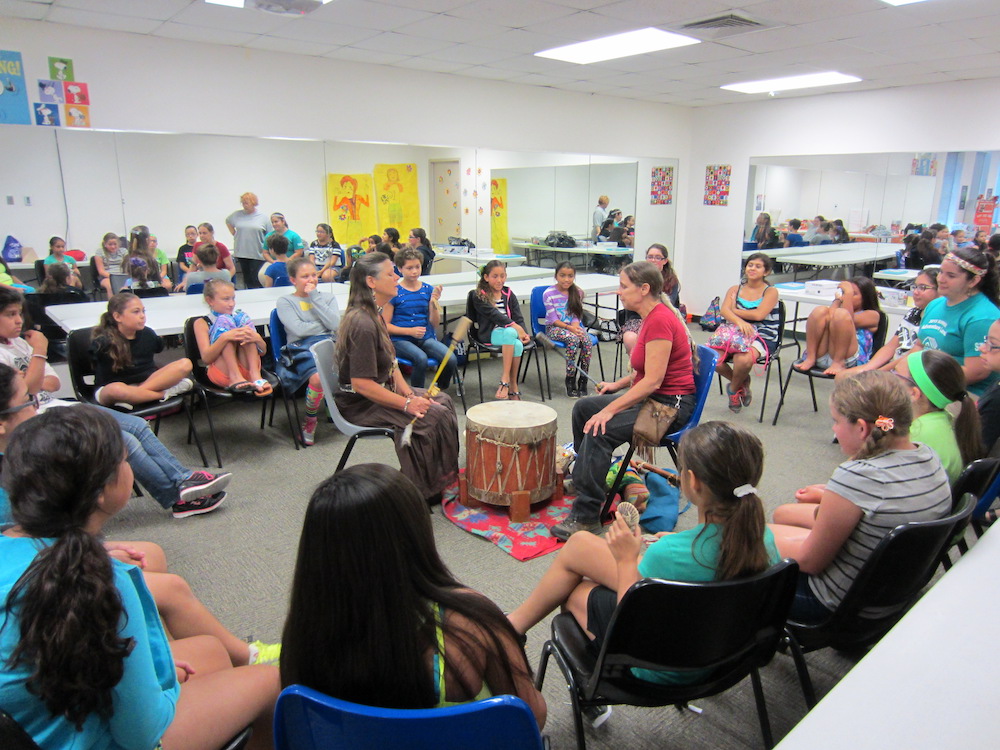
Just a few of the people who help the Good Samaritan Rescue Mission run smoothly are (from left) George Quintanilla, laundry; Alfred Martinez, assistant to director; Carole Murphrey, executive director; Tatiana McCormick, animal care; “Gilbert,” landscape services; and Ronald Plagge, food service. Front and center is Simba the ginger tabby cat, who is both a well-loved board member and resident. Photo by Jane Kathleen Gregorio
Currently the largest shelter in the region, the Good Samaritan Rescue Mission does much more than provide 24 percent of the shelter beds in Nueces County. Its 37 different programs have helped thousands of homeless get back on their feet with food, clothing, shelter, and a newly instilled sense of pride, responsibility, and hope — without spending a dime in taxpayer money.
“We neither seek nor accept any federal, state, or local monies, and are not members of United Way,” said Executive Director Carole Murphrey, who has been with the organization since 1988. “This gives us flexibility to offer a bed to every person who walks in, without them having to qualify for a program or go through a case worker.”
Since 1953, the Good Samaritan Rescue Mission has helped thousands of people who had lost everything find a fresh start. After Hurricane Harvey last year, the number of people taking refuge at Good Samaritan increased dramatically. Some people who lost their homes are still trying to get back on their feet almost a year after the storm.
“As of now, we have around 230 beds that are occupied, and that is more than this building can handle,”said Murphrey, adding that they still do not turn anyone away. “We are the only shelter that is open day and night around the clock where men and women can check in any time.”
In the last year, the Good Samaritan was able to provide lodging for 240 people a night and serve 298,000 plates of nutritious food. Each resident gets three meals a day and two snacks. A coffee shop with donated pastries is open from 6 a.m.-10 a.m. and 6 p.m.-10 p.m., providing a safe place for residents to connect with each other.
Another unique feature of this shelter: The homeless help the homeless. Except for Murphrey, each of the 30-plus staff members first came to the shelter seeking help.
“They have walked a mile in the shoes of those they serve,” Murphrey said. “This creates an instant bond for the staff members and the homeless persons, because they understand where the other comes from.”
With the exception of mental or physical disabilities, residents participate in a “Work for Bed” program where people may stay as long as needed if they report to the Welcome Center each morning for chores.
“We have five shifts of simple tasks such as clearing the dining table dishes, cleaning the lobby, picking up trash, etc.,” Murphrey said. “If a person gets a job or receives a government check, they pay us a small rent to simulate the independent life they will have when they leave Good Sam.”
The organization believes in innovation from the bottom up — responsibility, work, purpose, and independence — rather than dependence on Good Sam or Uncle Sam.
“We believe in the homeless we serve, even when they have lost their ability to believe in themselves,” Murphrey said. “Our ministry and all of our house rules and policies are a result of collaboration directly with the homeless we serve.”
During the past year, Good Sam found day labor work for 244 men and women. Twenty percent of the residents began their employment through day labor, out of an average of 51 percent who eventually obtained full-time jobs.
Nineteen percent of the residents are disabled. The Good Samaritan is the only shelter in the area that provides a Medical Dorm where the local hospitals can discharge their indigent patients to continue their recovery. Those residents receive home health, oxygen, IVs, and hospice service. Two doctors donate their services to assist residents and provide prescriptions.
Good Sam also is the only shelter that does not require an ID .
“We accept homeless with no ID because so many of them have been mugged and had their backpacks stolen with all their legal papers inside,” Murphrey said. “We help with and pay for ID restoration.”
That level of help and commitment requires a great deal of community support, something Corpus Christi residents have shown a lot of for the past 60 years.
As the number of people needing assistance increases, the need for supplies and monetary support increases as well. The Good Samaritan Rescue Mission needs donations of groceries, operational supplies, toiletries, and money (see sidebar).
“We aren’t your typical shelter because we don’t want to just provide residents a roof over their heads and food,” Murphrey said. “ We want them to bond with others, to make friends and feel like they are coming home, and that we are all one happy dysfunctional family. One thing homeless people need the most is to feel a sense of security and belonging and to have the chance to connect back to the world. We want to help our residents to have a vision and to give them support to get back on their feet and make a new plan.”
Good Samaritan Rescue and Mission is located at 210 S. Alameda St. (at Kinney St.). The mailing address is P.O. Box 65, Corpus Christi, Texas 78403-0065. For more information, contact (361) 765-0297 or email GoodSamCC@aol.com. Visit the website at goodsamcc.org.
| FOOD Eggs, milk, tomato sauce, chicken broth, cream of mushroom soup, ground beef, hot dogs, chicken, sandwich meat, frozen or canned meat, vegetables, fruit, potatoes, onions, breakfast cereals, biscuit mix, sack lunch snacks, coffee, hot chocolate, instant tea, pasta, condiments, sugar, and artificial sweeteners. SHELTER OPERATION Firewood, Duraflame logs, propane RESIDENT NEEDS Padlocks for lockers, men’s and women’s undergarments, small bags to carry toiletries to shower, towels, wash cloths, flip flops, shower shoes, bath robes, 2X-3X size clothing for men and women, blankets, twin-size flat and fitted sheets, tube socks, gloves, caps, 3X-10X size coats and sweaters, raincoats, ponchos and sweat suits, and pet food (as residents can bring their pets with them). TOILETRIES Toothbrush, toothpaste, disposable razors, shaving cream, shampoo, conditioner, bar soap, small comb, deodorant, Q-tips, pocket- or purse-size tissues, approx. 6 ft. of folded toilet paper, feminine hygiene products, razors, combs, deodorant and heavy duty plastic sandwich and storage bags. THRIFT ITEMS The Good Samaritan also picks up material donations such as furniture, appliances, electronics, and clothing to sell in its thrift store. The store provides a resource for clothing and items for clients as well as a source of revenue to help with operating expenses. The store is located at 210 S. Alameda St. Donation pick ups can be made by calling (361) 249-7817. |




